For Birds, Weathering is More Than Just Fair. It’s High-Quality Care That Promotes Good Welfare!
One of the most common questions that the Rosamond Gifford Zoo’s animal care team hear about the birds of prey in our Weathering Yard is, “What are those birds doing?” We know that, like us, our guests always have our animals’ best interests at heart. This question comes from a place of genuine concern and curiosity. Not only that, but this question provides us with the chance to have an informative and educational conversation with our guests, and we always welcome the opportunity to do so.
The short answer to that question is, “They’re weathering, which is a positive process that promotes natural behavior and overall welfare for our raptors.”
Interested in the longer, more detailed answer? We figured you would be. Read on for a crash course in weathering! 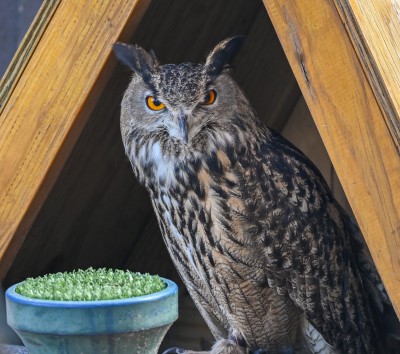
Caring for birds of prey has a long, developed history. Historical evidence suggests that the practice of falconry (that is, the keeping, training, and hunting with birds of prey) dates back to circa 2000BCE in Mesopotamia. Over the next four thousand years, falconry (as both a sport and a cultural pastime) evolved and grew in popularity, spreading throughout Asia, Africa, Europe, and the Americas (New York State Falconry Association). Because falconry has such a rich historical record, falconers have been able to track and to develop good husbandry practices for the many species of raptors. This experience, combined with extensive research of wild birds of prey, makes a compelling case in favor of the physical and psychological benefits that weathering gives birds. As an institution accredited by the Association of Zoos and Aquariums (AZA), the Rosamond Gifford Zoo prioritizes animal welfare in all that we do. Because of our commitment to give every animal the best possible care we can give, we make the choice to weather our birds of prey who often participate in educational programs, such as our Hawk Walk encounters, animal demonstrations during special events, and group classes. This includes falcons, hawks, and owls.
When we use the term “weathering,” what we mean is the practice of mimicking the birds’ natural instincts and physiological rhythms of energy conservation. Most predators, birds of prey included, will naturally seek opportunities to conserve energy. After all, hunting is difficult! It requires a lot of energy to track and to kill prey, especially when flight is involved. To be able to hunt effectively, wild birds of prey prepare by spending the majority of their day safely perched and relatively still. This gives them a chance to rest their bodies before they need to exert the great effort it is to seek and to kill prey. In other words, our birds are not forced to remain perched while they are being weathered. Rather, weathering gives the birds the chance to exhibit their natural inclination to avoid expending energy. 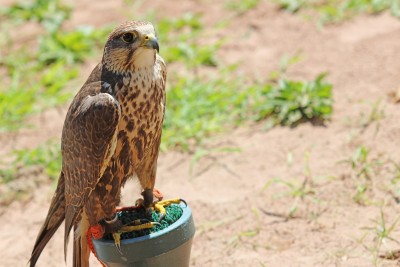
“For large raptors, burning energy is costly,” explains Lucas Whitman, former Collection Manager of Birds at the Rosamond Gifford Zoo. “The more the birds move and fly around, the more energy they expend. The more energy they expend, the more they need to recover by eating more or resting. Hunting success is never a guarantee, though. The more efficient way for birds to maintain energy is by conserving energy. That’s what weathering does.”
Weathered birds get to spend time in our outdoor Weathering Yard, safely and comfortably tethered with access to everything they would need throughout the day. As you will see when you visit the yard, each bird has multiple perching options with a variety of textures, the ability to choose to be indoors or outdoors, a bath pan, access to both direct sunlight and shade, and a sandy substrate. The birds’ time in the Weathering Yard provides ample choice so that they can arrange themselves as they wish while conserving energy. Their A-frame structures have padded perching both inside and on top of the roofs. Eagon the Eurasian eagle owl, for example, often opts to perch inside his structure, which makes sense given that wild Eurasian eagle owls often spend time in dark, enclosed cavity areas. On the other hand, Saker falcon Padme does not have a structure because falcons have longer wings than most other species of raptors. An A-frame structure could risk damaging Padme’s long wings, so her perching needs are met with other options to suit her better. In fact, sometimes, she even chooses not to perch at all, which she is free to do. “Padme likes to lay right down in the sand,” reports Whitman, noting the different preferences and habits of each individual bird. “So, that’s what she does. She can make the choice to do so at her weathering station.”
Not only are the textures of these types of perches different, but they have different widths to allow the birds to grasp onto the perch with varying positions of their feet and talons, which promotes foot health. Due to their unique physiology, birds are especially vulnerable to foot injuries, so any preventative measures the animal care team can take to protect their feet helps avoid long-term complications. The blocks to which the birds are tethered also serve as an opportunity for flat perching. By offering the birds multiple perching and environmental options, we provide the birds with agency and autonomy so that they can choose what they want whenever they are being weathered. The options resemble the diverse types of branches birds encounter in the wild.
Even the birds’ tethers are specifically designed for optimal weathering experience. The tethers are made with a soft, bungee cord-like material that prevents any tangling or pulling on the birds. To further provide the birds comfort, the tethering system consists of multiple welded rings and swivels capable of rotating 360° attached to jesses (thin leather straps used when birds sit on a glove or fly during a demonstration) attached to aylmeri (soft leather anklets) worn by the birds. The length of the tether gives the birds the room they need to access their stations fully. Weathered birds are thus never in direct contact with the metal components of the system, not at risk of wrapping themselves around their tethers, and never jerked backwards by their tethers. All weathering equipment is monitored and maintained for peak performance and bird safety. 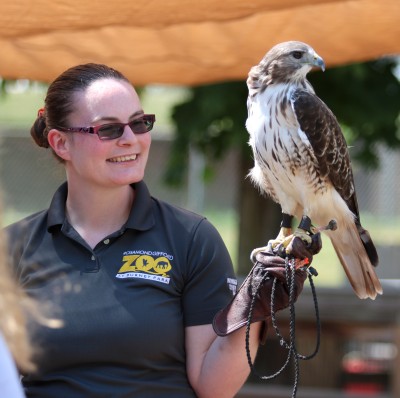
As with every animal in our care, we make sure to monitor our birds frequently, both through behavioral and physical observations. These observations are then recorded using ZooMonitor, an app created by the Lincoln Park Zoo to support effective animal care by collecting and organizing behavioral data. We’ve observed that our weathered birds maintain good body condition, which is a strong sign of their overall health. Maintaining proper Vitamin D levels from exposure to sunlight, for example, is vital to have healthy bones, beaks, and feathers.
“Our ZooMonitor program gives great insights that affirmed weathering is an effective way to manage these species of birds,” Whitman notes. “When our data showed that we needed to adjust things, we did.” He explains shortly after the team decided to implement weathering, Casper, a Saker falcon/Gyrfalcon hybrid, displayed signs of anxiety. To ease the bird’s nervousness, the team relocated Casper’s weathering station to an area where a wall behind him provided more security. As a result of this change, Casper grew calmer and more comfortable during his time in the Weathering Yard.
Through our frequent monitoring, research, and data analysis, we’ve found that weathered birds display species-specific behaviors and metabolic indicators that show the birds are relaxed, healthy, and thriving. Be on the lookout for some of these indicative behaviors when you visit our Weathering Yard! Some examples of these behaviors you might catch include a wing-stretch, rouse, or one-legged balance. True to its name, a wing-stretch refers to a bird’s wing movement to stimulate their muscles and circulation as they rest. A rouse is a term that refers to when birds shake out their feathers to realign them, often in response to some sort of startling stimuli. Rousing essentially soothes a bird after a moment of uncertainty or nervousness. When birds rouse, it is a physical signal that the momentary danger, perhaps a loud noise or sudden gust of wind, has passed. Although balancing on one leg might not be the most relaxing posture for humans (unless you’re in the middle of a yoga class), one-legged balancing is an action birds take to conserve energy when they feel relaxed and unthreatened. 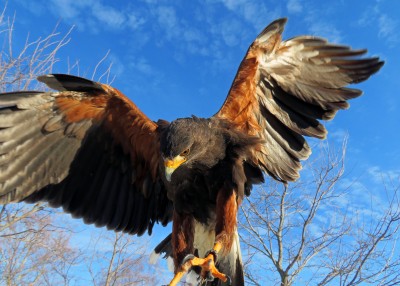
Weathering also gives the birds physical, mental, and cognitive stimulation. Spending time outdoors gives them the chance to interact with an always-changing environment. This form of enrichment can even include the chance to react to predators, another completely naturally behavior that they would exhibit in the wild. According to Whitman, “If a wild eagle flies overheard, our falcons will usually call out. There’s a special vocalization they use. It’s so neat to hear.” Not only that, but, as Whitman points out, reacting to a predator is very much a natural behavior for the birds. “They respond appropriately to their environment, just as they would in nature. Opportunities like that are exactly what we want to give them.”
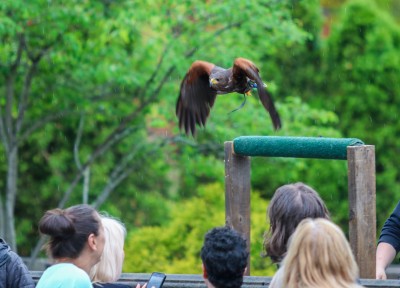 Weathering supplies birds with the chance to spend that large part of their day conserving energy, just as they would in the wild. What about that small part of the day when the birds’ energy levels would naturally increase— when they would normally move about the skies, hunting for food and flying to new locations? Our amazing animal care team provides this experience for the birds, as well. Weather-permitting, when it is time for birds to be fed (typically in the afternoon), members of the bird team will give the birds training and free-flight opportunities. Free-flighting involves allowing the birds to fly naturally as a caretaker provides lures and prey to mimic hunting. This routine fulfills the birds’ need for exercise and their ingrained instincts to hunt.
Weathering supplies birds with the chance to spend that large part of their day conserving energy, just as they would in the wild. What about that small part of the day when the birds’ energy levels would naturally increase— when they would normally move about the skies, hunting for food and flying to new locations? Our amazing animal care team provides this experience for the birds, as well. Weather-permitting, when it is time for birds to be fed (typically in the afternoon), members of the bird team will give the birds training and free-flight opportunities. Free-flighting involves allowing the birds to fly naturally as a caretaker provides lures and prey to mimic hunting. This routine fulfills the birds’ need for exercise and their ingrained instincts to hunt.
“We do everything we can to give these birds as close to a wild experience as we possibly can. Weathering helps achieves that, and we have the data to back that up,” Whitman confirms. “Our top concern is providing the best life for our birds. Weathering is a part of that. Observing those natural, species-specific behaviors drives home that weathering is a positive, beneficial experience,” he says. “That’s what we want to see.” 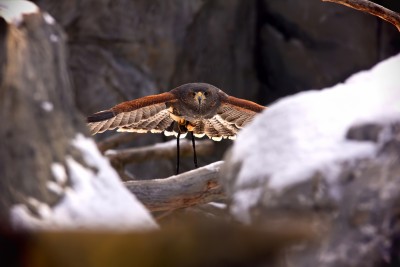
When you visit our Weathering Yard, you can be sure that the birds you see are healthy, happy, and provided with everything they need to live a high-quality life.
Interested in learning more about the art and science of falconry? For more information, check out the International Association of Avian Trainers and Educators (IAATE) at https://iaate.org/.
Works Cited
N.A. History. New York State Falconry Association. https://nysfa.org/becoming-a-falconer/history/.
Works Consulted
International Association of Avian Trainers and Educators. (2019). Position statement: Tethering and the use of jesses. IAATE. https://iaate.org/wp-content/uploads/2022/09/PositionStatement_Tethering-and-the-Use-of-Jesses_2019.pdf


